Influence of Different Contact Conditions on Friction Properties of AISI 430 Steel Sheet with Deep Drawing Quality
Abstract
1. Introduction
2. Materials and Methods
2.1. Materials
2.2. Experimental Procedures
2.2.1. Pin-on-Disk Test
2.2.2. Formability Tests
3. Results and Discussion
3.1. Pin-on-Disk Test
3.2. Formability Tests
3.3. Comparative Analysis
4. Conclusions
- Differences observed in the COF value indicate a strong dependence of the friction properties of the material with the kinematic conditions of the different tribological tests.
- The COF value in the PoD test, under dry conditions, and pin with roughness Ra = 0.27 μm and Ra = 0.54 μm was approximately 0.536 and 0.673, respectively, i.e., higher among all the friction conditions investigated. The contact area between the specimen/pin was much smaller compared to that of the formability tests, and the normal pressure exerted by the pin on the specimen caused a rapid expansion of the real contact area, increasing the frictional resistance. Under lubricated conditions, the COF value was approximately 0.139 and 0.237, respectively.
- In the BUT and STT tests, the COF increased with the increase in relative elongation due to increased strip roughness. For the pin with roughness Ra = 0.27 μm, the COF value was approximately 0.207 and 0.102, respectively. However, for the pin with roughness Ra = 0.54 μm, the COF value was approximately 0.223 and 0.123, respectively. As a result of the relative elongation, wide and thin ridges were formed on the strip surfaces subjected to both formability tests, which increased the COF value and strip surface wear.
- The highest lubrication efficiency of 10.3% and 13% for the BUT and STT tests, respectively, was recorded using the pin with a roughness Ra = 0.27 μm, strip orientation of 0°, and relative elongation of 0.03, most probably owing to the lower degree of flattening of strip asperities, which functioned as an adequate reservoir of lubricant to the tribocontact.
- The pressure distribution was not uniform at the contact interface between the strip and pin during the formability tests.
- The hardness measured in the samples submitted to the PoD, BUT, and STT tests increased, on average, approximately 80%, 54%, and 43% under condition dry, and 76%, 46%, and 31%, under condition lubricated, respectively. This increase can be attributed to the strain hardening mechanism, which in turn results from the flattening of asperities owing to the high roughness and counter sample hardness.
- The experimental results of COFs can be used as input data for numerical simulations, define design guidelines, improve productivity, and improve product quality from this material.
Author Contributions
Funding
Institutional Review Board Statement
Informed Consent Statement
Data Availability Statement
Acknowledgments
Conflicts of Interest
References
- Zhao, D.; Zhao, K.; Song, H.; Ren, D.; Ying Chang, Y. Influence of geometric attributes on friction coefficient in sheet metal stamping. Sci. Mech. 2021, 12, 945–958. [Google Scholar] [CrossRef]
- Azushima, A. Tribological Technology in Sheet Metal Forming. Materials Forming, Machining and Tribology, 1st ed.; Springer: Singapore, 2022; pp. 1–33. [Google Scholar]
- Holmberg, K.; Erdemir, A. Influence of tribology on global energy consumption, costs and emissions. Friction 2017, 5, 263–284. [Google Scholar] [CrossRef]
- Trzepiecinski, T.; Lemu, H.G. Recent Developments and Trends in the Friction Testing for Conventional Sheet Metal Forming and Incremental Sheet Forming. Metals 2020, 10, 47. [Google Scholar] [CrossRef]
- Xu, Z.; Huang, J.; Mao, M.; Peng, L.; Lai, X. An investigation on the friction in a micro sheet metal roll forming processes considering adhesion and ploughing. J. Mater. Proc. Technol. 2020, 285, 116790. [Google Scholar] [CrossRef]
- Luiz, V.D.; Amaral, E.C.; de Souza, V.P.; de Matos Rodrigues, P.C. Influência da velocidade de estampagem e anisotropia no comportamento tribológico e fratura de uma chapa de aço AISI 430Nb. Materia 2022, 27, e20148196. [Google Scholar]
- Trzepiecinski, T.; Lemu, H. Effect of Lubrication on Friction in Bending under Tension Test-Experimental and Numerical Approach. Metals 2020, 10, 544. [Google Scholar] [CrossRef]
- Luiz, V.D.; de Matos Rodrigues, P.C. Effect of the test conditions on tribological behavior of an Nb-stabilized AISI 430 stainless steel sheet. J. Braz. Soc. Mech. Sci. Eng. 2021, 43, 505. [Google Scholar] [CrossRef]
- Baltatu, M.S.; Vizureanu, P.; Sandu, A.V.; Munteanu, C.; Istrate, B. Microstructural Analysis and Tribological Behavior of Ti-Based Alloys with a Ceramic Layer Using the Thermal Spray Method. Coatings 2020, 10, 1216. [Google Scholar] [CrossRef]
- Paleu, C.C.; Munteanu, C.; Istrate, B.; Bhaumik, S.; Vizureanu, P.; Bălţatu, M.S.; Paleu, V. Microstructural Analysis and Tribological Behavior ofAMDRY 1371 (Mo–NiCrFeBSiC) Atmospheric Plasma Spray Deposited Thin Coatings. Coatings 2020, 10, 1186. [Google Scholar] [CrossRef]
- Staeves, J. Beurteilung der Topografie von Blechen im Hinblick auf die Reibung bei der Umformung. Ph.D. Thesis, Technical University of Darmstadt, Darmstadt, Germany, 1998. [Google Scholar]
- Schell, L.; Groche, P. In Search of the Perfect Sheet Metal Forming Tribometer. In Forming the Future, Proceedings of the 13th International Conference on the Technology of Plasticity, Columbus, OH, USA, 25–30 July 2021; Daehn, G., Cao, J., Kinsey, B., Tekkaya, E., Vivek, A., Yoshida, Y., Eds.; The Minerals, Metals & Materials Series; Springer: Cham, Switzerland, 2021. [Google Scholar]
- Bensaid, K.; Fredj, N.B. Influence of Sliding Speed and Normal Loads on the Wear Resistance of Hardox 500 Steel Ground Surfaces. In Advances in Mechanical Engineering, Materials and Mechanics, Proceedings of the ICAMEM 2019, Hammamet, Tunisia, 16–18 December 2019; Kharrat, M., Baccar, M., Dammak, F., Eds.; Lecture Notes in Mechanical Engineering; Springer: Cham, Switzerland, 2021; pp. 84–90. [Google Scholar]
- Trzepieciński, T. A study of the coefficient of friction in steel sheets forming. Metals 2019, 9, 988. [Google Scholar] [CrossRef]
- Luiz, V.D.; de Matos Rodrigues, P.C. Design of a tribo-simulator for investigation of the tribological behavior of stainless-steel sheets under different contact conditions. Mater. Res. 2022, 25, e20210220. [Google Scholar] [CrossRef]
- Trzepieciński, T.; Najm, S.M. Application of artificial neural networks to the analysis of friction behaviour in a drawbead profile in sheet metal forming. Materials 2022, 15, 9022. [Google Scholar] [CrossRef]
- Trzepieciński, T. Polynomial multiple regression analysis of the lubrication effectiveness of deep drawing quality steel sheets by eco-friendly vegetable oils. Materials 2022, 15, 1151. [Google Scholar] [CrossRef] [PubMed]
- Bay, N.; Olsson, D.D.; Andreasen, J.L. Lubricant test methods for sheet metal forming. Tribol. Int. 2008, 41, 844–853. [Google Scholar] [CrossRef]
- Schmitz, T.L.; Action, J.E.; Ziegert, J.C.; Sawyer, W.G. The difficulty of measuring low friction: Uncertainty analysis for friction coefficient measurements. J. Tribol. 2005, 127, 673–678. [Google Scholar] [CrossRef]
- Codd, D.S. Automotive Mass Reduction with Martensitic Stainless Steel; SAE Technical Paper 2011-01-0427; SAE International: Warrendale, PA, USA, 2011. [Google Scholar]
- Moon, J.; Ha, H.Y.; Kim, K.W.; Park, S.J.; Lee, T.H.; Kim, S.D.; Jang, J.H.; Jo, H.H.; Hong, H.U.; Lee, B.H.; et al. A new class of lightweight, stainless steels with ultra-high strength and large ductility. Sci. Rep. 2020, 10, 12140. [Google Scholar] [CrossRef]
- Luiz, V.D.; de Matos Rodrigues, P.C. Failure analysis of AISI 430 stainless steel sheet under stretching and bending conditions. Int. J. Adv. Manuf. Technol. 2022, 121, 2759–2772. [Google Scholar] [CrossRef]
- Olsson, C.-O.; Landolt, D. Passive films on stainless steels—Chemistry, structure and growth. Electrochim. 2003, 48, 1093–1104. [Google Scholar] [CrossRef]
- Zuazo, I.; Hallstedt, B.; Lindahl, B.; Selleby, M.; Soler, M.; Etienne, A.; Perlade, A.; Hasenpouth, H.; Massardier-Jourdan, V.; Cazottes, S.; et al. Low-density steels: Complex metallurgy for automotive applications. JOM 2014, 201466, 1747–1758. [Google Scholar] [CrossRef]
- Chen, S.; Rana, R.; Haldar, A.; Ray, R.K. Current state of Fe–Al–Mn–C low density steels. Prog. Mater. Sci. 2017, 89, 345–391. [Google Scholar] [CrossRef]
- Kirkhorn, L.; Bushlya, V.; Andersson, M.; Stahl, J.-E. The influence of tool steel microstructure on friction in sheet metal forming. Wear 2013, 302, 1268–1278. [Google Scholar] [CrossRef]
- ISSF. The Ferritic Solution: Properties, Advantages, Applications. 2020. Available online: https://www.worldstainless.org/Files/issf/non-image-files/PDF/ISSF_The_Ferritic_Solution_English.pdf (accessed on 30 November 2022).
- Tanure, L.; Alcântara, C.M.; Santos, D.B.; Oliveira, T.R.; Gonzalez, B.M.; Kim Verbeken, K. Microstructural characterization and mechanical behavior during recrystallization annealing of Nb-stabilized type ASTM 430 and Nb-Ti-stabilized ASTM 439 ferritic stainless steels. J. Mater. Res. Technol. 2019, 8, 4048–4065. [Google Scholar] [CrossRef]
- ASTM A240:2012; Standard Specification for Chromium and Chromium-Nickel Stainless Steel Plate, Sheet, and Strip for Pressure Vessels and for General Applications. American Society for Testing and Materials: West Conshohocken, PA, USA, 2012.
- EN ISO 6892-1:2020; Specifies the Method for Tensile Testing of Metallic Materials and Defines the Mechanical Properties Which Can Be Determined at Room Temperature. International Organization for Standardization: Geneva, Switzerland, 2020.
- Banabic, D.; Bunge, H.-J.; Pöhlandt, K.; Tekkaya, A.E. Formability of Metallic Materials: Plastic Anisotropy, Formability Testing, Forming Limits. Springer: Berlin/Heidelberg, Germany, 2000. [Google Scholar]
- ASTM E8:2016; Standard Test Methods for Tension Testing of Metallic Materials. American Society for Testing and Materials: West Conshohocken, PA, USA, 2016.
- Rabinowicz, E. Friction and Wear of Materials, 2nd ed.; John Wiley & Sons Ltd.: New York, NY, USA, 1995. [Google Scholar]
- Archard, J.F. Contact and Rubbing of Flat Surfaces. J. Appl. Phys. 1953, 24, 981–988. [Google Scholar] [CrossRef]
- ASTM G99-05:2010; Standard Test Method for Wear Testing with a Pin on Disk Apparatus. American Society for Testing and Materials: West Conshohocken, PA, USA, 2010.
- Andreasen, J.L.; Olsson, D.D.; Chodnikiewicz, K.; Bay, N. Bending under tension test with direct friction measurement. Proc. Inst. Mech. Eng. B J. Eng. Manuf. 2006, 220, 73–80. [Google Scholar] [CrossRef]
- Hutchings, I.M.; Shipway, P. Tribology: Friction and Wear of Engineering Materials, 2nd ed.; Butterworth-Heinemann: Cambridge, UK, 2017. [Google Scholar]
- Bhushan, B. Introduction to Tribology, 2nd ed.; John Wiley & Sons Ltd.: New York, NY, USA, 2013. [Google Scholar]
- Holmberg, K.; Matthews, A. Coatings Tribology: Properties, Mechanisms, Techniques and Applications in Surface Engineering, 2nd ed.; Elsevier Sciense: London, UK, 2009. [Google Scholar]
- Wang, J.; Zhou, X.; Thompson, G.E.; Hunter, J.A.; Yuan, Y. Delamination of near-surface layer on cold rolled AlFeSi alloy during sheet forming. Mater. Charact. 2015, 99, 109–117. [Google Scholar] [CrossRef]
- Suh, N.P. The delamination theory of wear. Wear 1973, 25, 111–124. [Google Scholar] [CrossRef]
- Schey, J.A. Tribology in Metalworking: Friction, Lubrication, and Wear. J. Appl. Metalwork. 1984, 3, 173. [Google Scholar] [CrossRef]
- Masters, L.G.; Williams, D.K.; Roy, R. Friction behaviour in strip draw test of pre-stretched high strength automotive aluminium alloys. Int. J. Mach. Tools Manuf. 2013, 73, 17–24. [Google Scholar] [CrossRef]
- Xiaoguang Ma, X.; Zhao, J.; Du, W.; Zhang, X.; Jiang, L.; Jiang, Z. An analysis of ridging of ferritic stainless steel 430. Mater. Sci. Eng. A 2017, 685, 358–366. [Google Scholar]
- Shin, H.J.; An, J.K.; Park, S.H.; Lee, D.N. The effect of texture on ridging of ferritic stainless steel. Acta Mater. 2003, 51, 4693–4706. [Google Scholar] [CrossRef]
- Trzepieciński, T.; Bazan, A.; Lemu, H.G. Frictional characteristics of steel sheets used in automotive industry. Int. J. Automot. Technol. 2015, 16, 849–863. [Google Scholar] [CrossRef]
- Ter Haar, R. Friction in Sheet Metal Forming, the Influence of (Local) Contact Conditions and Deformation. Ph.D. Thesis, Universiteit Twente, Enschede, The Netherlands, 1996. [Google Scholar]
- Aksoy, M.; Kuzucu, V.; Korkut, M.H. The effect of niobium and homogenization on the wear resistance and some mechanical properties of ferritic stainless steel containing 17–18 wt.% chromium. J. Mater. Process. Technol. 1999, 91, 172–177. [Google Scholar] [CrossRef]
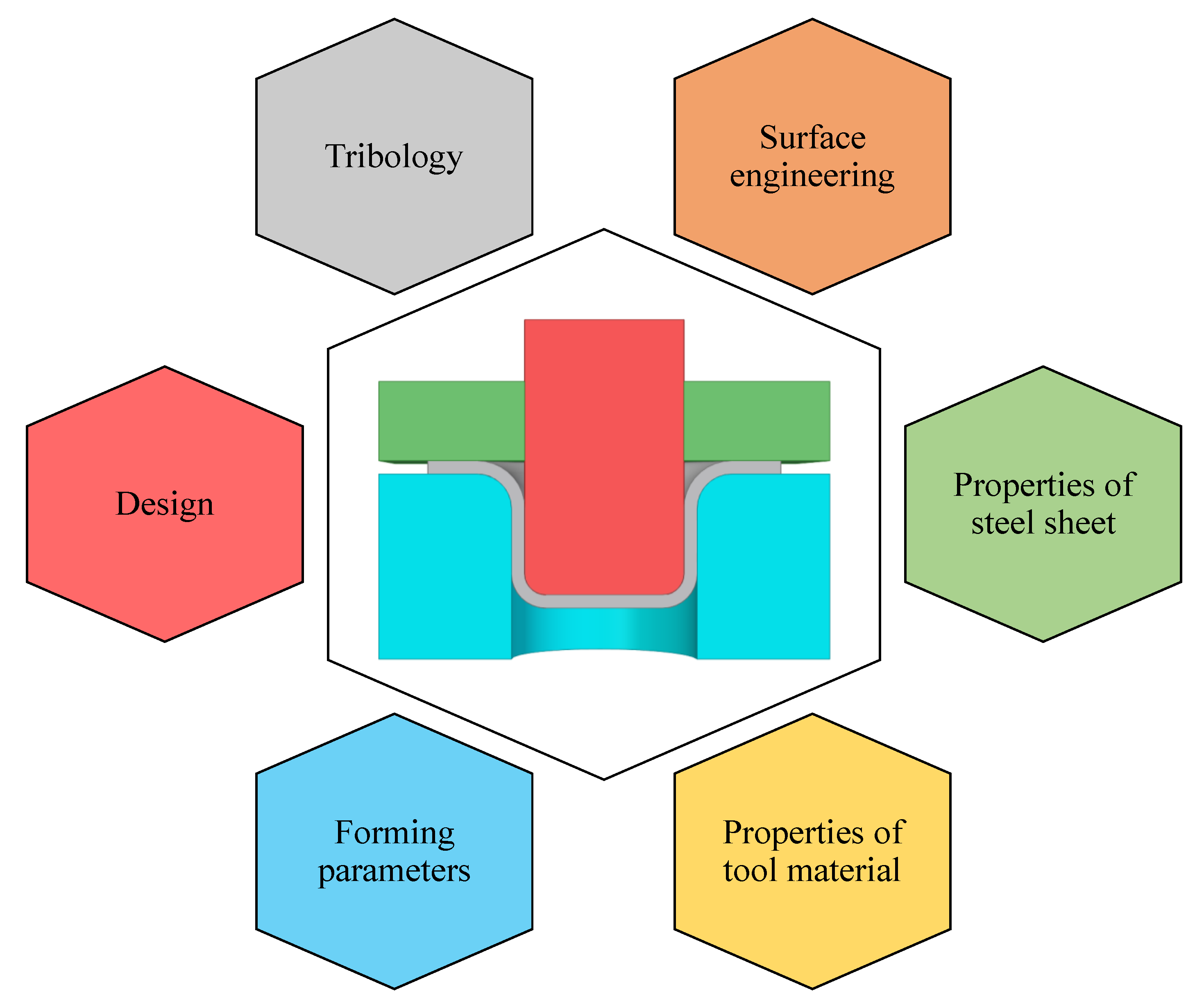
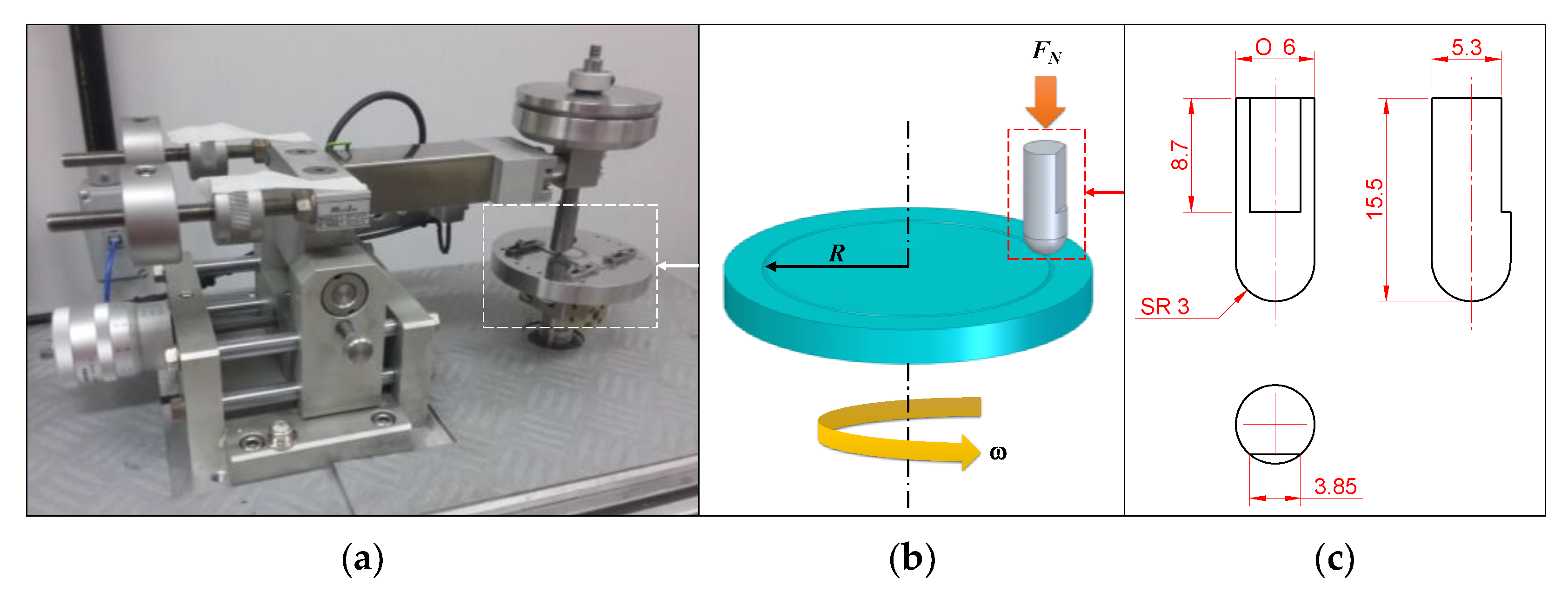
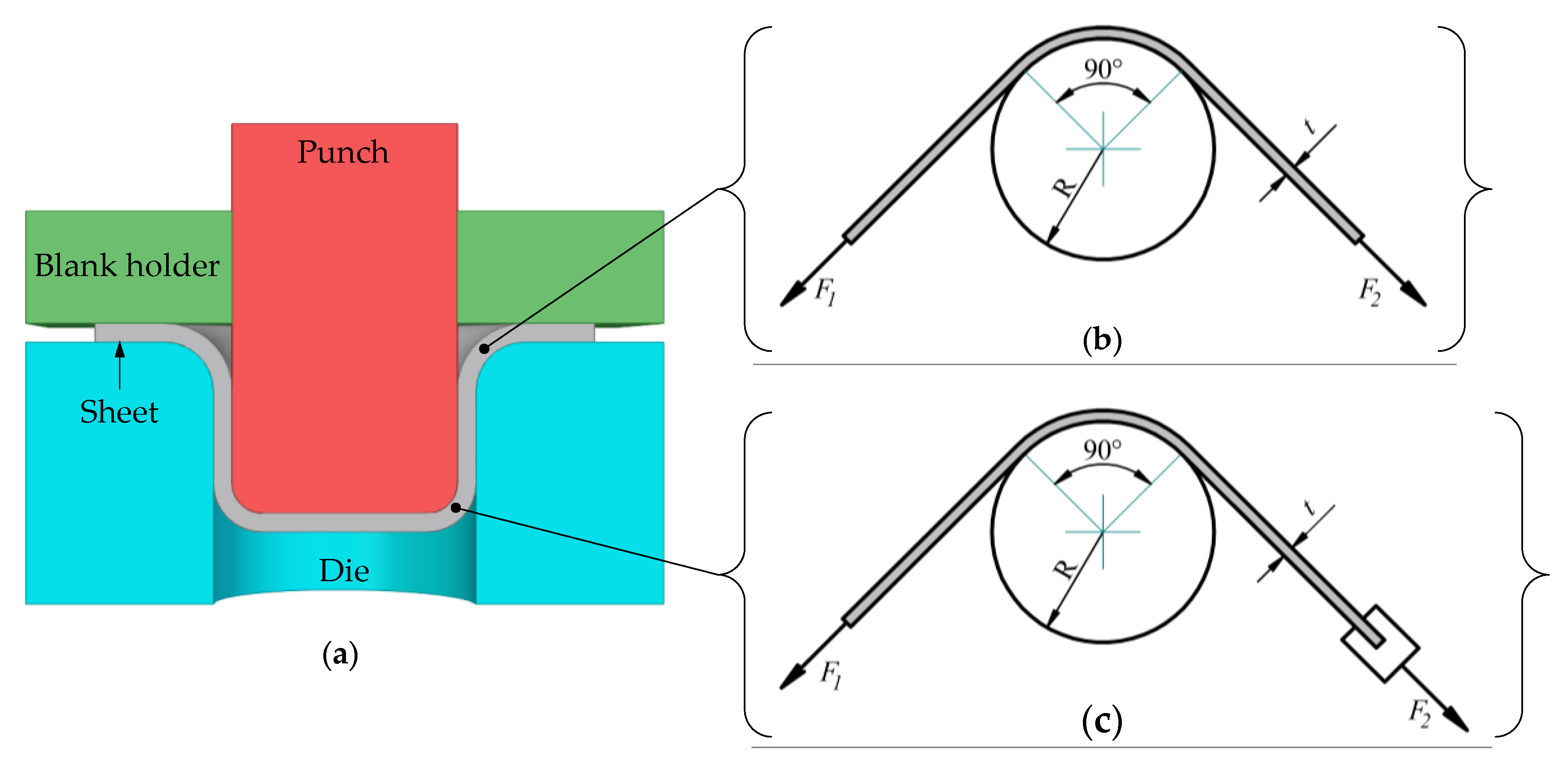
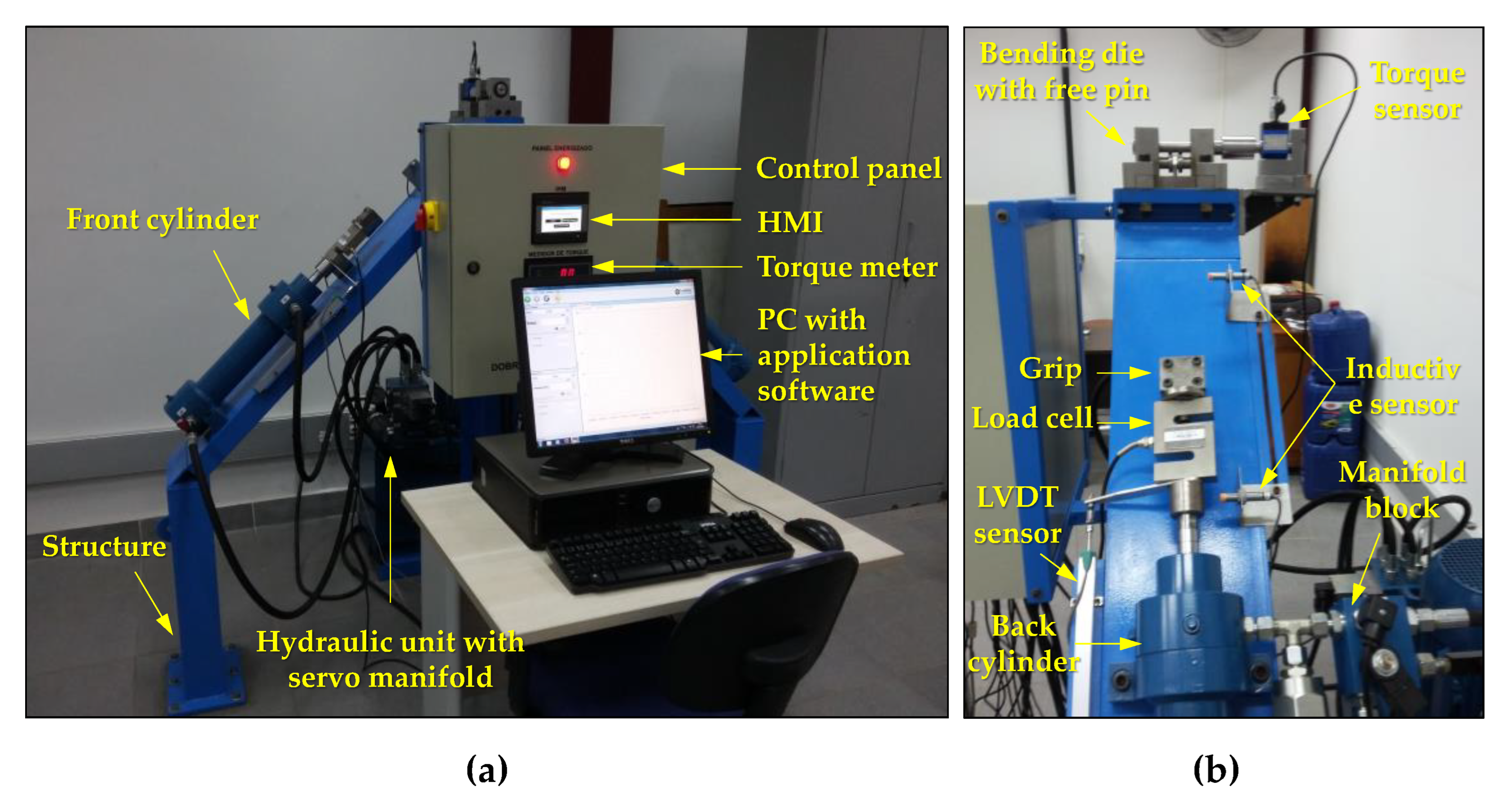
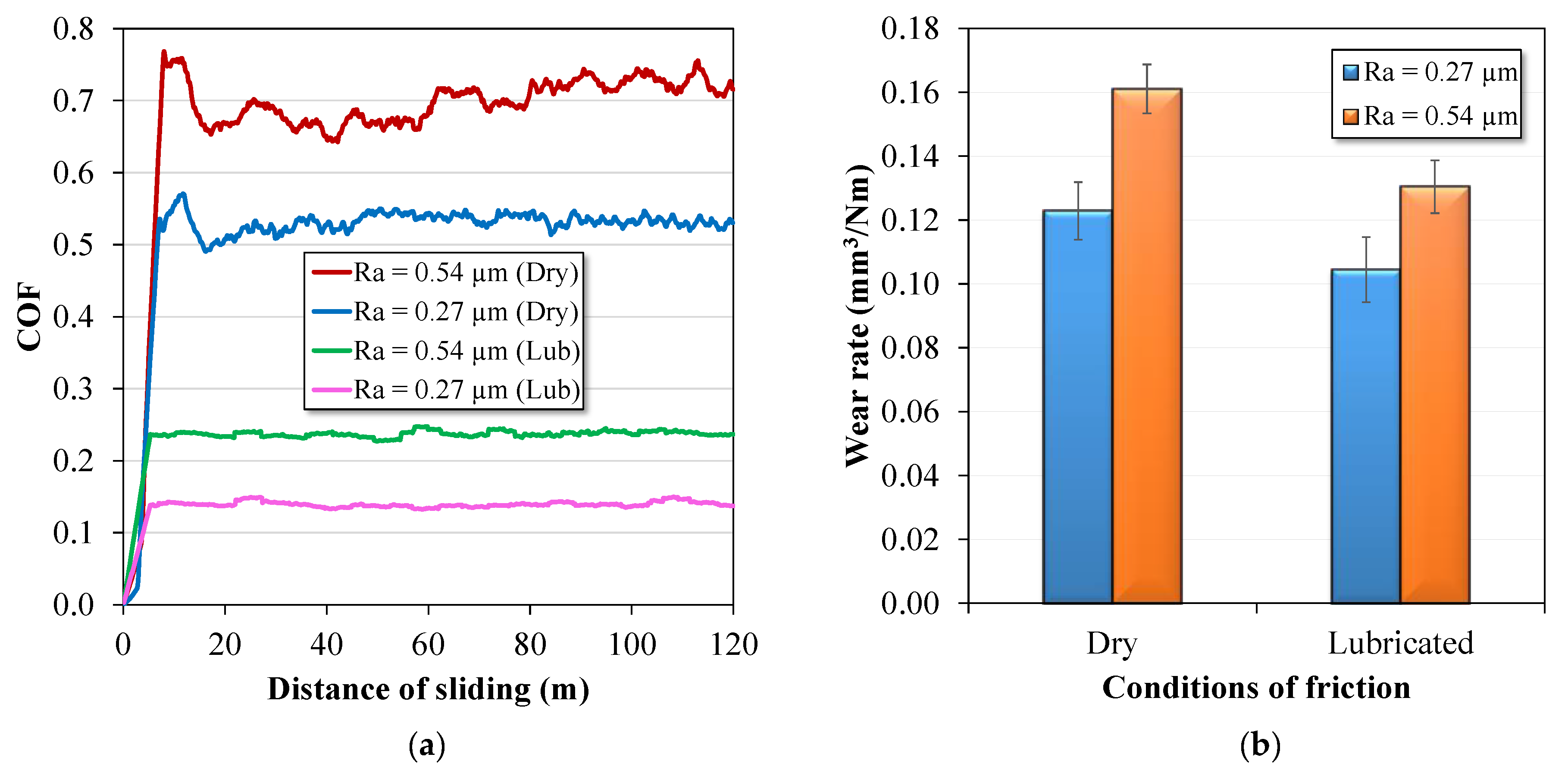
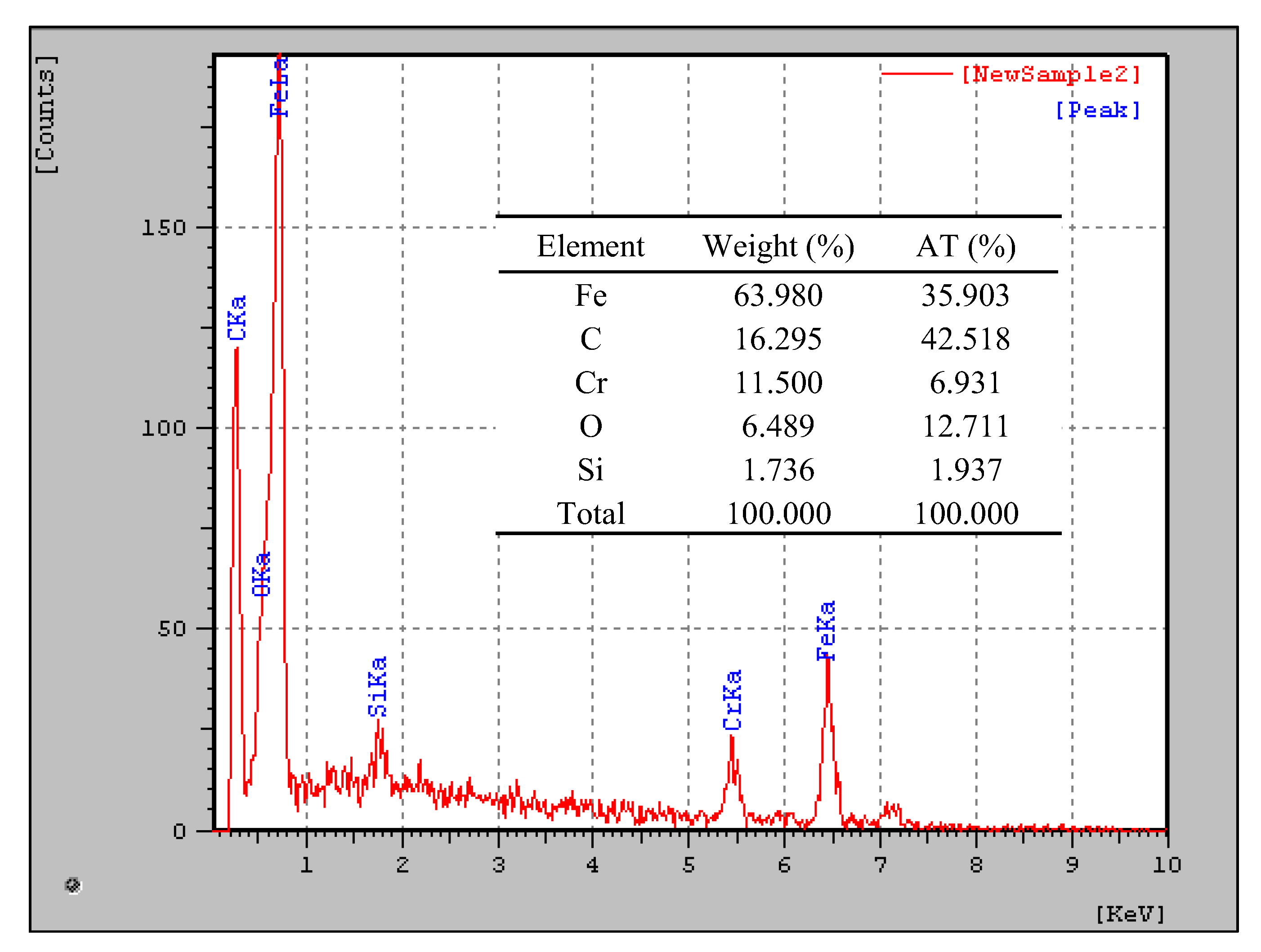

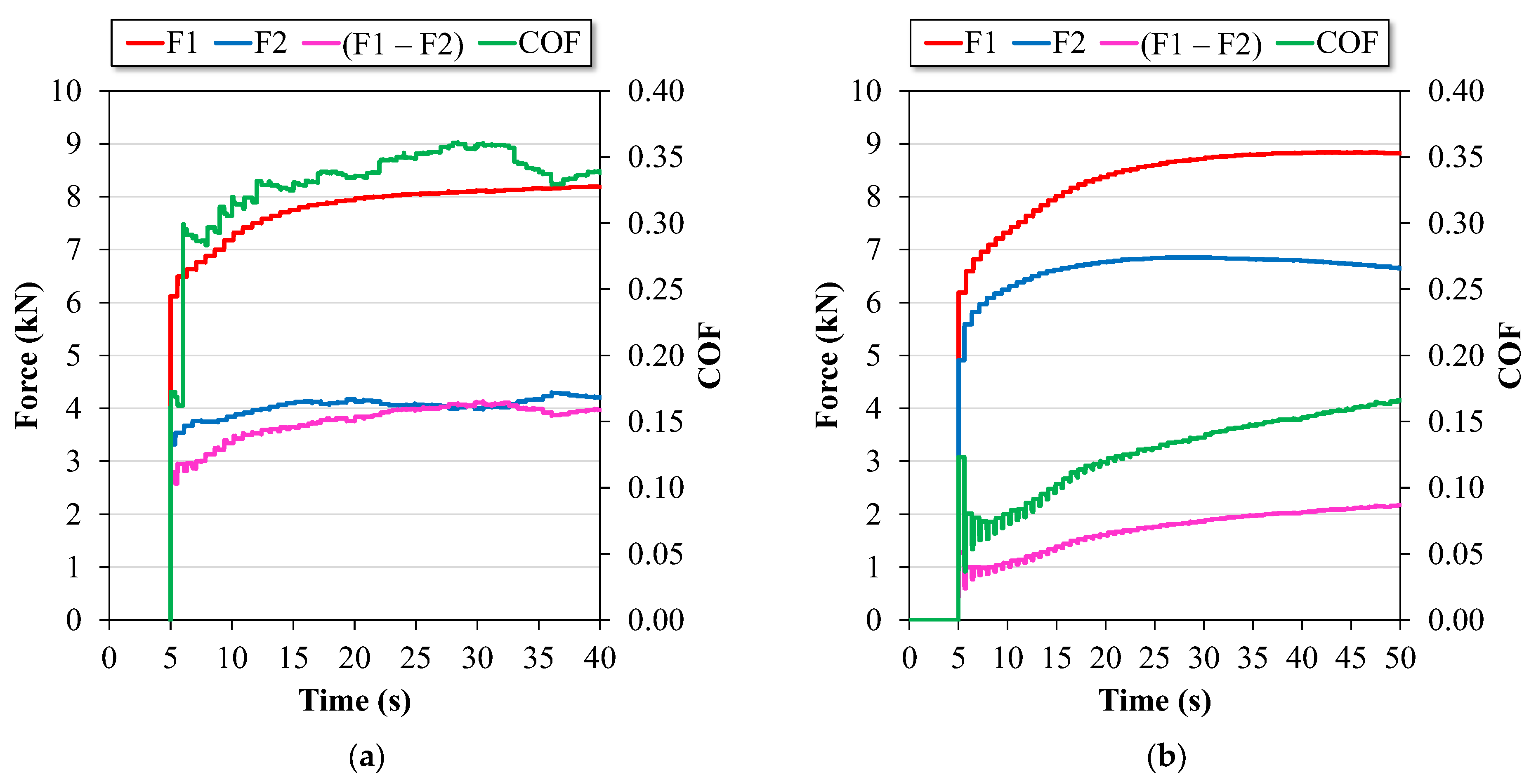
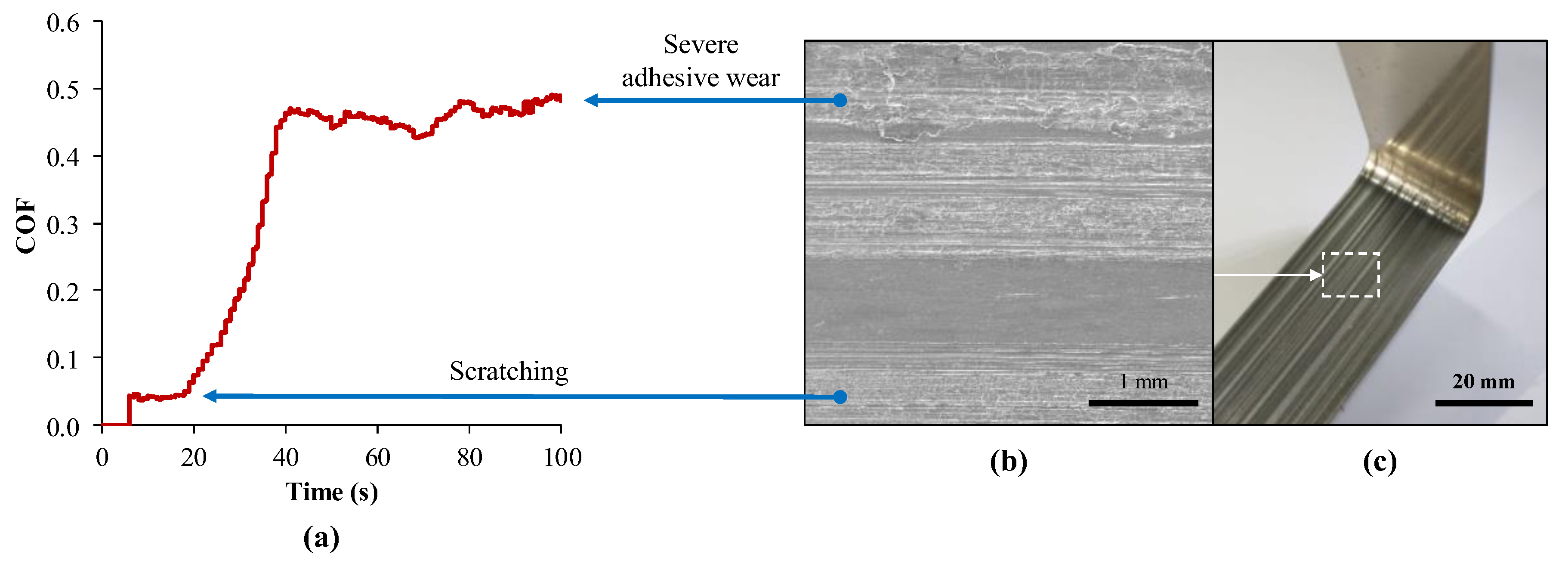
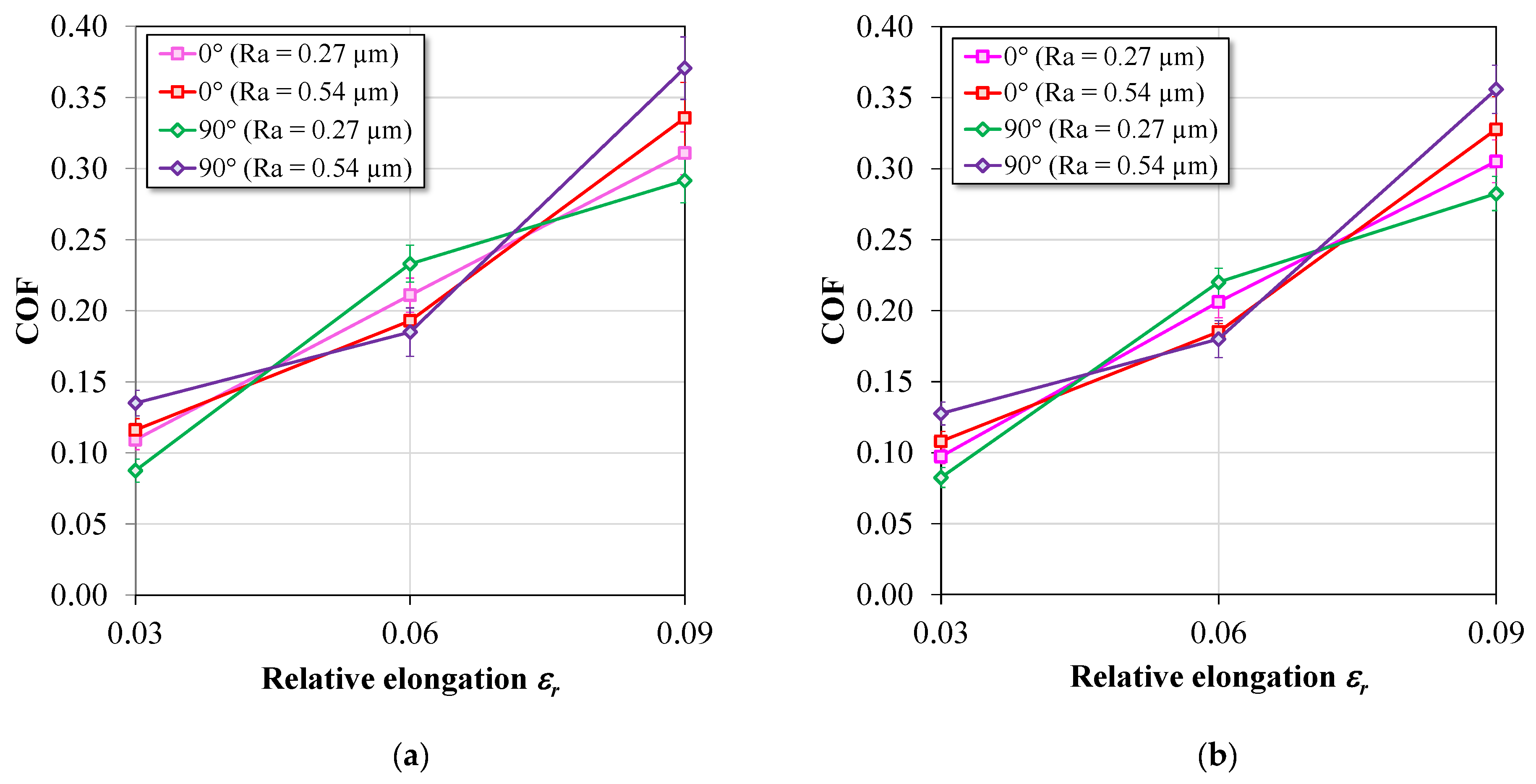
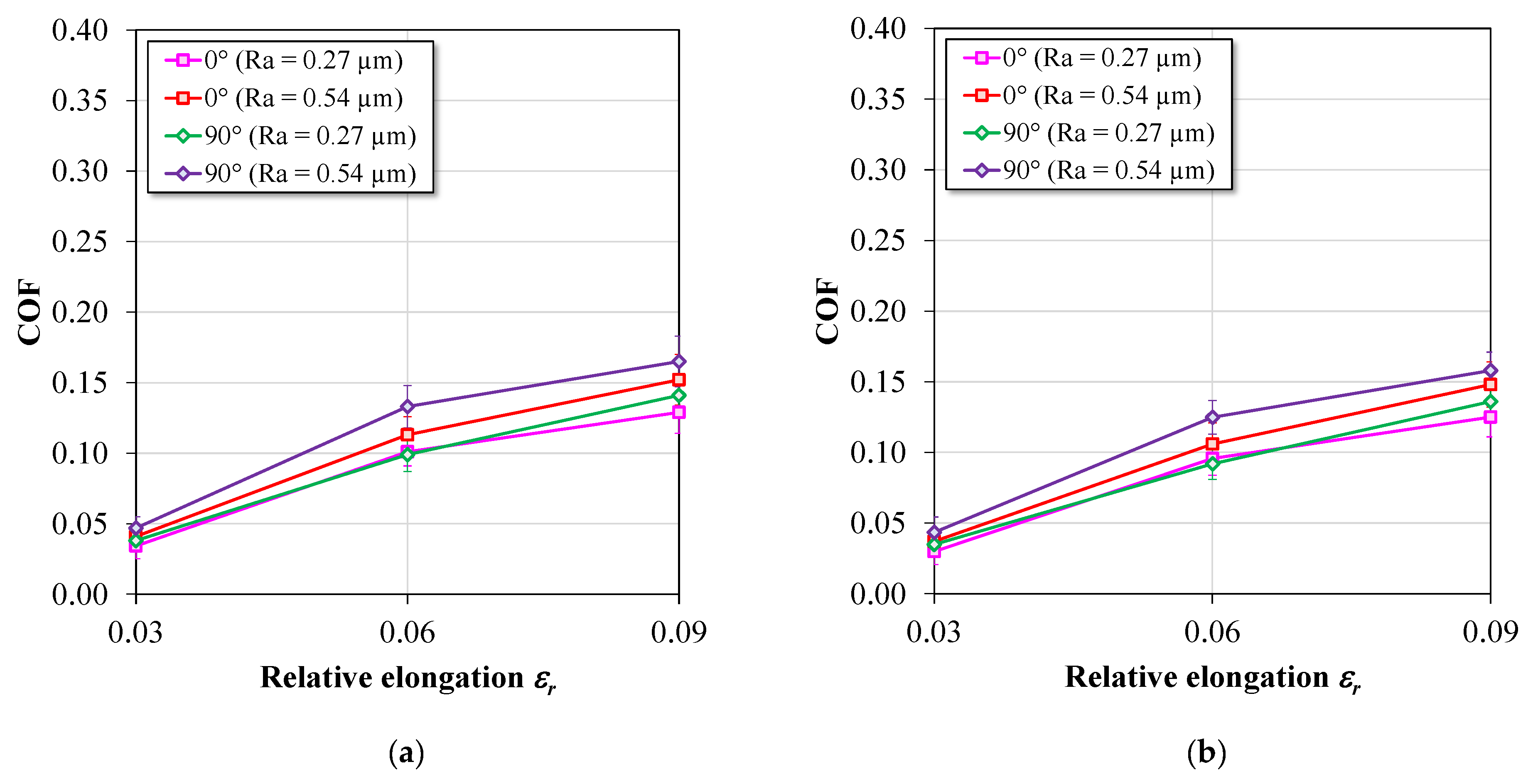
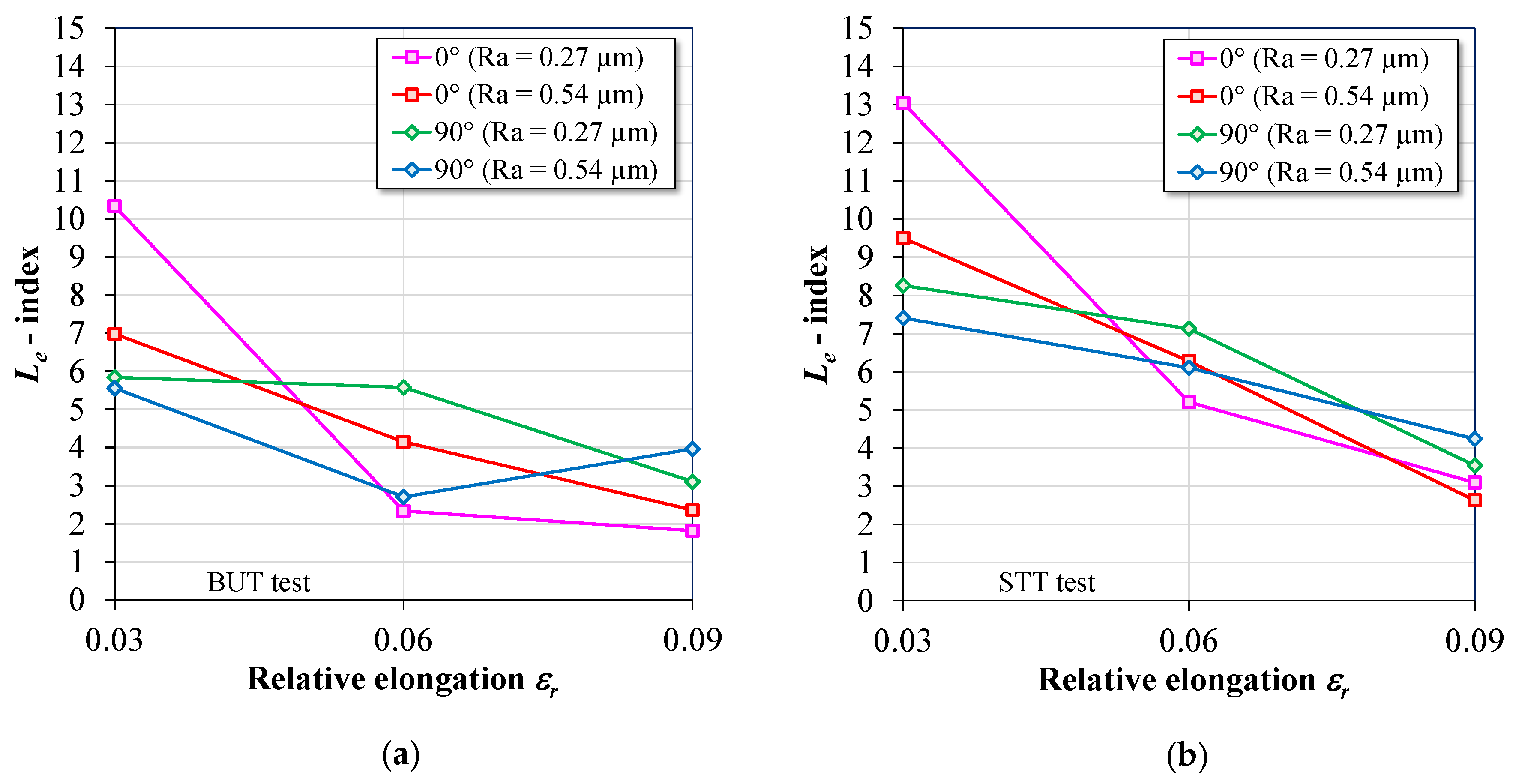
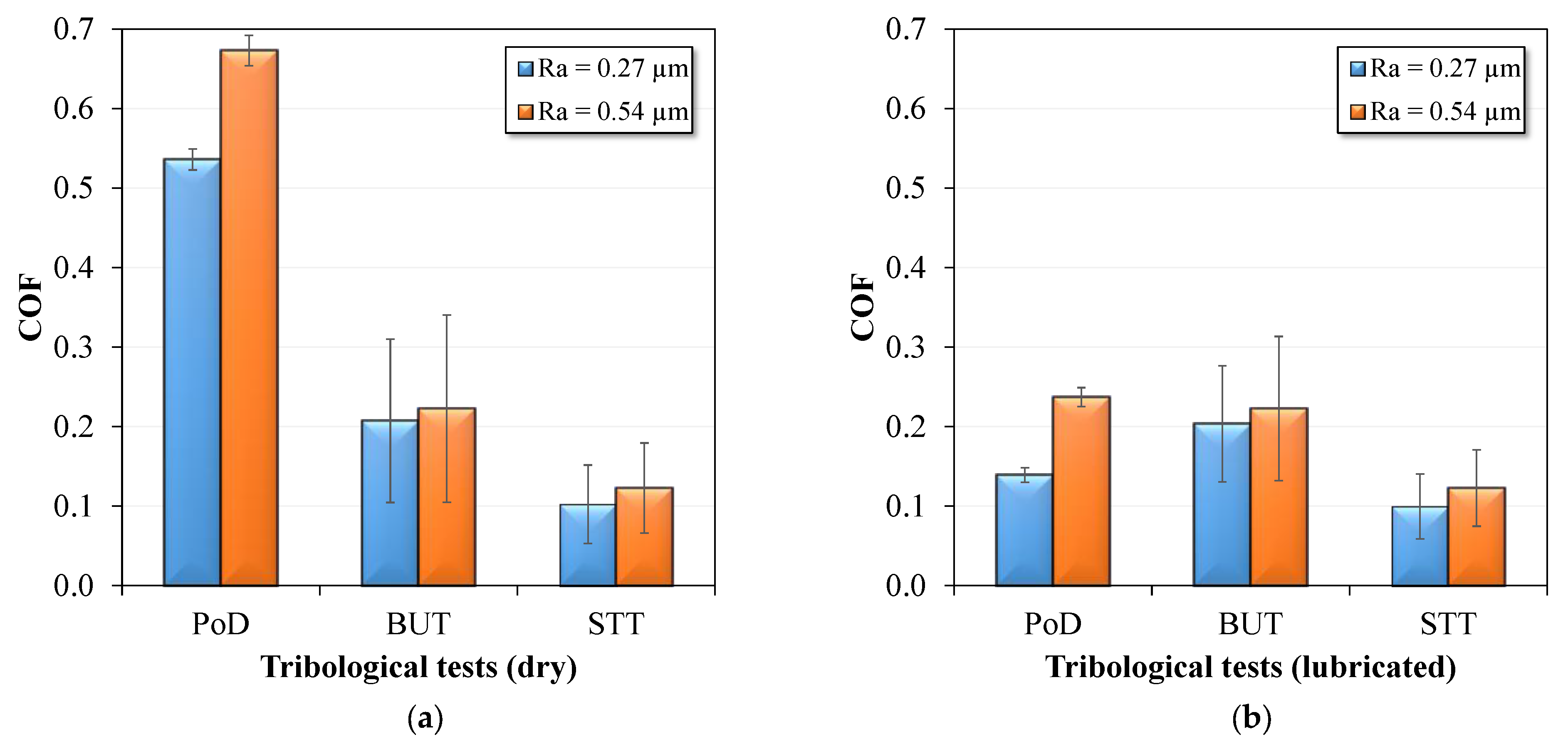
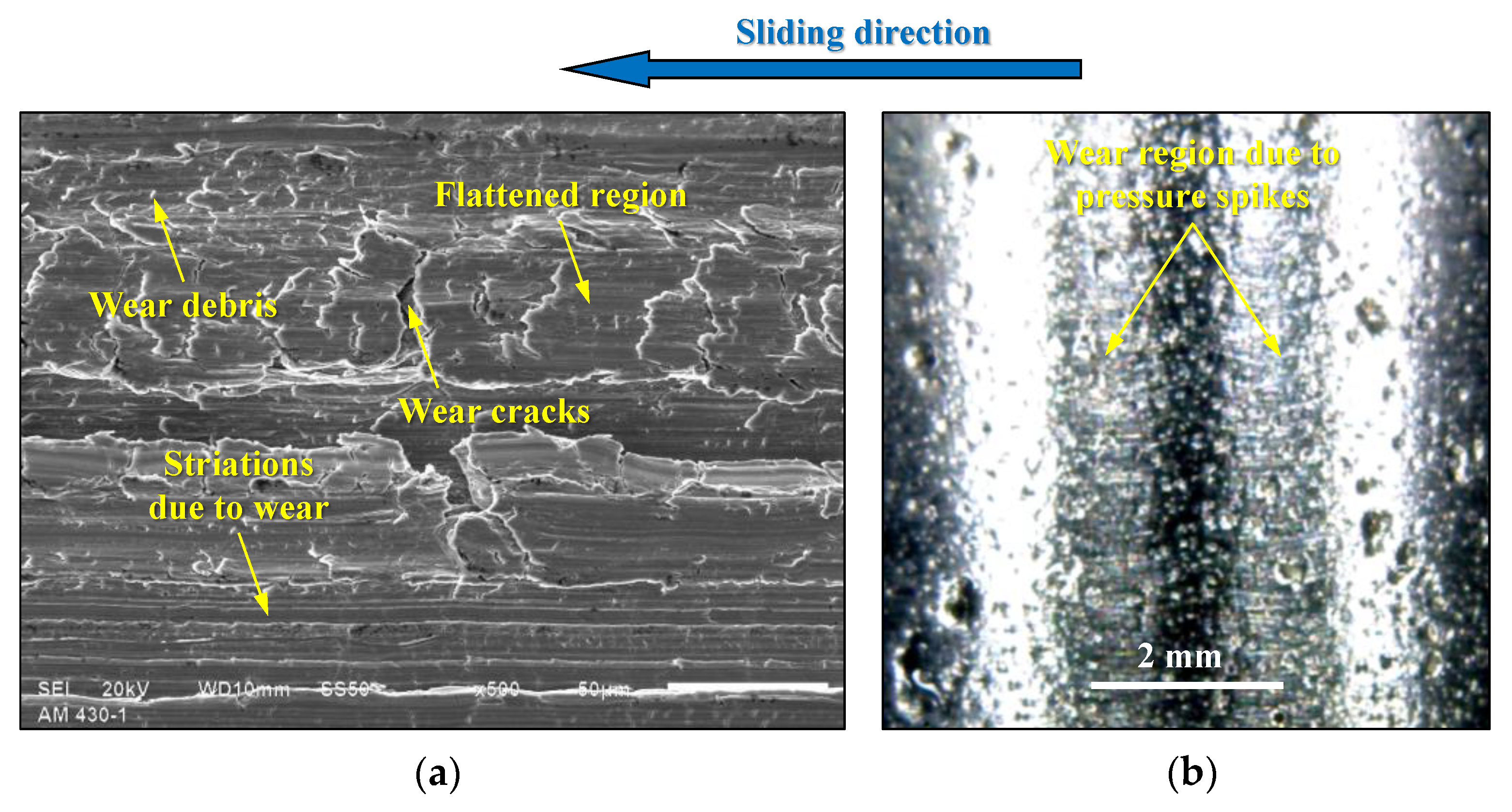
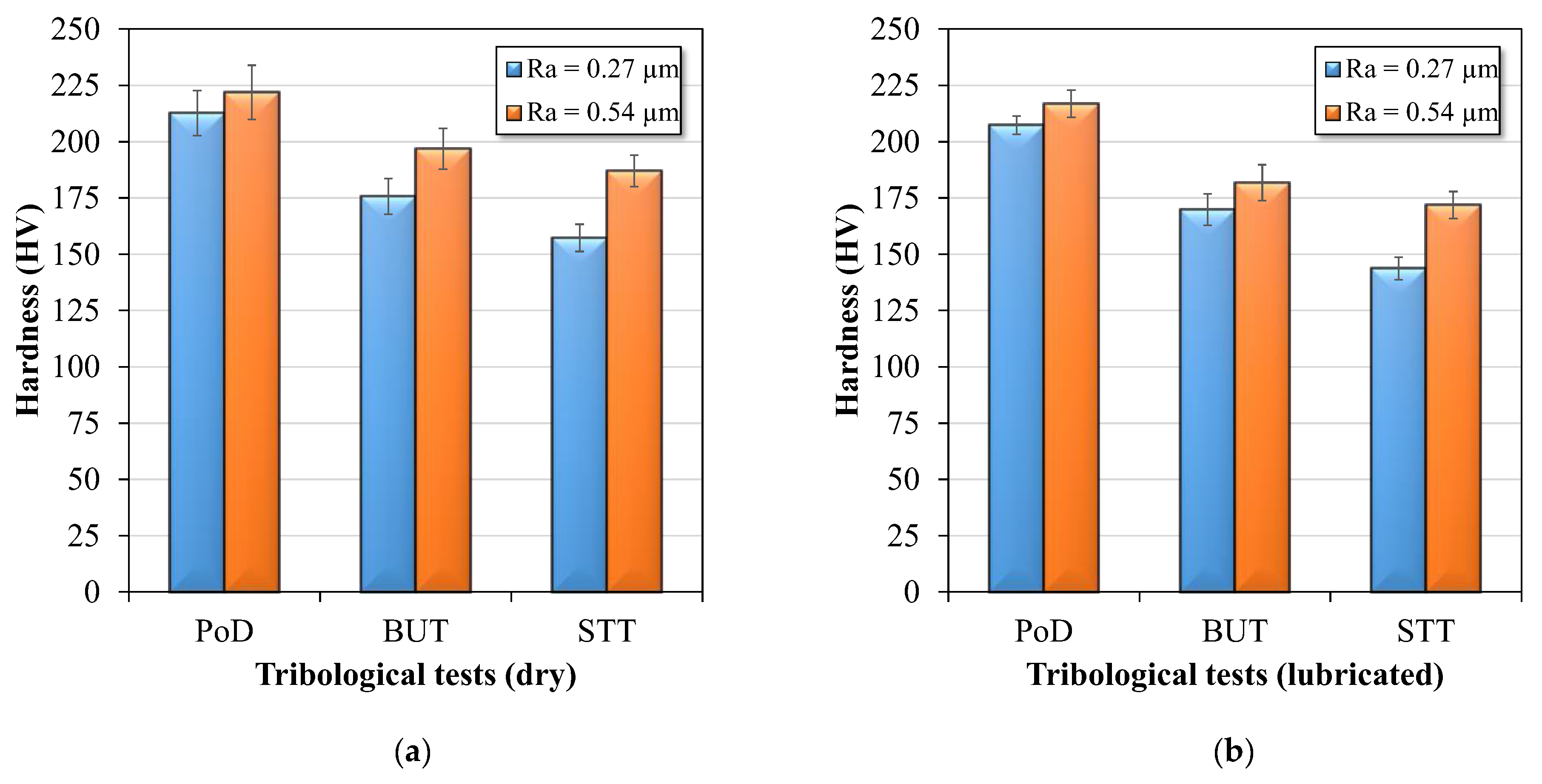
| C | Mn | Si | P | S | Ni | Cr | Mo | Nb | Ti | N (ppm) |
|---|---|---|---|---|---|---|---|---|---|---|
| 0.0164 | 0.2454 | 0.2447 | 0.0362 | 0.0009 | 0.2964 | 16.481 | 0.0234 | 0.3384 | 0.0035 | 231 |
| Direction | , MPa | , MPa | , % | n | r | Δr | ||
|---|---|---|---|---|---|---|---|---|
| 0° | 316.1 | 464.9 | 22.3 | 32.7 | 0.205 | 1.419 | 1.366 | 0.340 |
| 45° | 343.4 | 475.6 | 17.9 | 27.2 | 0.188 | 1.196 | ||
| 90° | 317.5 | 466.5 | 19.8 | 33.2 | 0.201 | 1.654 |
| Parameter | Description |
|---|---|
| Normal force | 15 N |
| Tangential speed | 0.2 m/s |
| Rotation speed | 191 rpm |
| Wear track radius | 10 mm |
| Sliding distance | 120 m |
| Specimen dimensions | 0.8 mm × 25 mm × 58 mm |
| Parameter | Description |
|---|---|
| Speed drawing | 10 mm/s |
| Pin radius | 9 mm |
| Relative elongation | 3%, 6%, and 9% |
| Specimen direction | 0° and 90° |
| Specimen dimensions × × | 0.8 mm × 25 mm × 750 mm |
Disclaimer/Publisher’s Note: The statements, opinions and data contained in all publications are solely those of the individual author(s) and contributor(s) and not of MDPI and/or the editor(s). MDPI and/or the editor(s) disclaim responsibility for any injury to people or property resulting from any ideas, methods, instructions or products referred to in the content. |
© 2023 by the authors. Licensee MDPI, Basel, Switzerland. This article is an open access article distributed under the terms and conditions of the Creative Commons Attribution (CC BY) license (https://creativecommons.org/licenses/by/4.0/).
Share and Cite
Luiz, V.D.; Santos, A.J.d.; Câmara, M.A.; Rodrigues, P.C.d.M. Influence of Different Contact Conditions on Friction Properties of AISI 430 Steel Sheet with Deep Drawing Quality. Coatings 2023, 13, 771. https://doi.org/10.3390/coatings13040771
Luiz VD, Santos AJd, Câmara MA, Rodrigues PCdM. Influence of Different Contact Conditions on Friction Properties of AISI 430 Steel Sheet with Deep Drawing Quality. Coatings. 2023; 13(4):771. https://doi.org/10.3390/coatings13040771
Chicago/Turabian StyleLuiz, Valmir Dias, Anderson Júnior dos Santos, Marcelo Araújo Câmara, and Paulo César de Matos Rodrigues. 2023. "Influence of Different Contact Conditions on Friction Properties of AISI 430 Steel Sheet with Deep Drawing Quality" Coatings 13, no. 4: 771. https://doi.org/10.3390/coatings13040771
APA StyleLuiz, V. D., Santos, A. J. d., Câmara, M. A., & Rodrigues, P. C. d. M. (2023). Influence of Different Contact Conditions on Friction Properties of AISI 430 Steel Sheet with Deep Drawing Quality. Coatings, 13(4), 771. https://doi.org/10.3390/coatings13040771






